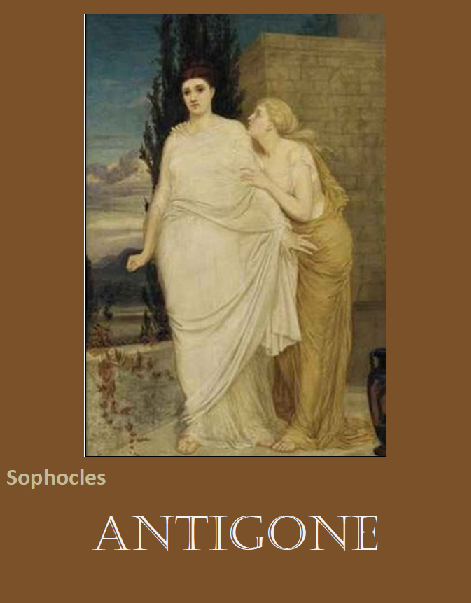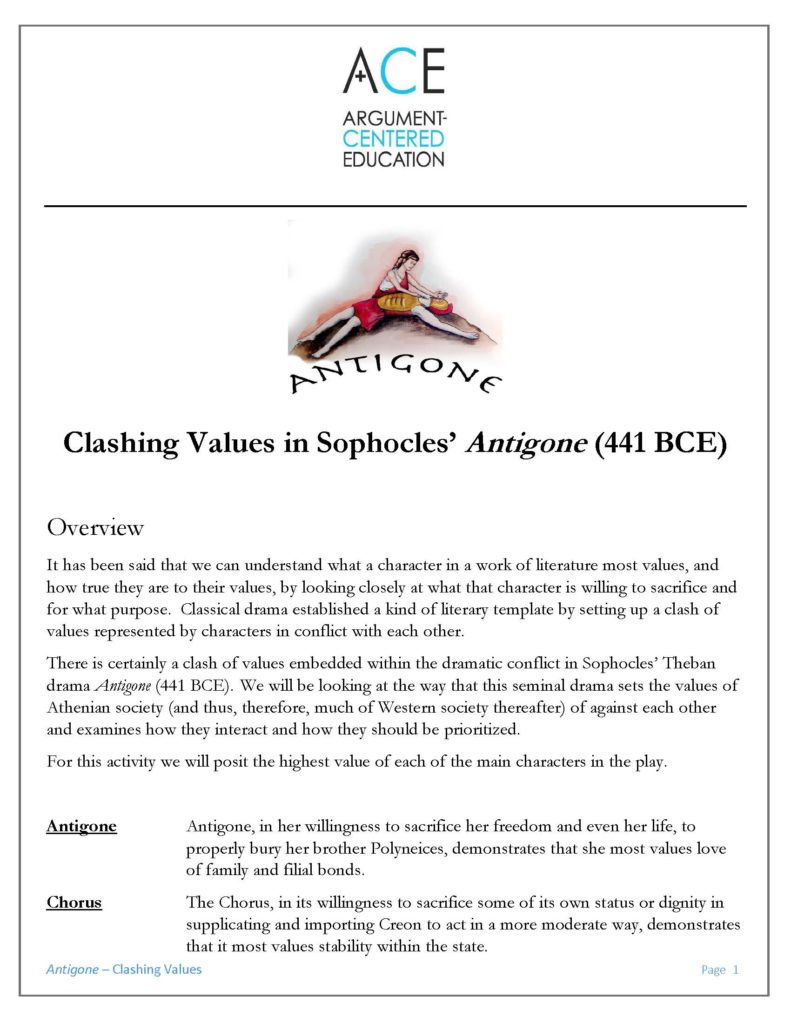
Clashing Values: ‘Antigone’ and Argument-Based Discussions in Small Groups
Overview
It has been said that we can understand what a character in a work of literature most values, and how true they are to their values, by looking closely at what that character is willing to sacrifice and for what purpose. Classical drama established a kind of literary template by setting up a clash of values represented by characters in conflict with each other.
There is certainly a clash of values embedded within the dramatic conflict in Sophocles’ Theban drama Antigone (441 BCE). These argument-based small-group discussions get students looking at the way that this seminal drama sets the values of Athenian society (and thus, therefore, much of Western society thereafter) off against each other and examines how they interact and how they are prioritized by the play (and by ourselves).

This activity posits the highest value of each of the main characters in the play.
Antigone
Antigone, in her willingness to sacrifice her freedom and even her life to properly bury her brother Polyneices, demonstrates that she most values love of family and filial bonds.
Chorus
The Chorus, in its willingness to sacrifice some of its own status or dignity in supplicating and importuning Creon to act in a more moderate way, demonstrates that it most values stability within the state.
Creon
Creon, in his willingness to kill his own daughters, demonstrates that he most values the authority of the father in the family and the authority of the ruler in the state.
Haemon
Haemon, in his willingness to sacrifice his own life when he finds Antigone’s dead body, demonstrates that he most values romantic love.
Ismene
Ismene, in her willingness to split with her sister and allow her to risk her life burying Polyneices by herself, demonstrates that she most values practical, pragmatic behavior in the face of crises.
The Sentry
The Sentry, in his willingness to sacrifice some of his own dignity in his frightened response to Creon’s threats, demonstrates that he most values personal survival over principles.
Tiresias
Tiresias, in his willingness to sacrifice his own comfort and peace of mind in his old age in engaging with Creon, demonstrates that he most values the wisdom that hard experience brings people in life.
This argument-based project will examine Antigone’s conflicting characters and clashing values, guided by these three questions.
Which character stays truest to their values throughout the play?
Which character’s (or characters’) values does the play endorse above the others?
Which character’s (or characters’) values do you personally endorse above the others?
Method and Procedure
This activity should be conducted after students have completed reading the play. They should have had an opportunity to discuss how particular plot incidents, dialogue, and literary techniques are used by Sophocles to demonstrate the characters’ values, as outlined above. (Note that teachers can adjust or change the definition of what a character most values. The list presented here is recommended, but there certainly are other viable understandings.)
(1)
Review what each of the seven main characters is willing to sacrifice and what they most value. Lead students in a discussion that identifies specific textual moments that demonstrate the characters’ values.
(2)
Introduce the three questions above that will guide the argument-based discussions that students will have on the clash of values in Antigone. Define any terms that may be unclear and check for understanding of the specific meaning of each question, and in particular the ways that the questions are distinct from each other.
(3)
Create heterogeneous groups of four students (it’s fine if there are a couple groups of three students, if the number of students in your class isn’t a factor of four).
(4)
Tell students to list out individually their top four characters, and their values, to each of the three questions. Then have students determine within their groups which character they will be defending in an argument-based discussion on each of the three questions. The way that this should be done is that a student should get their first-choice character if no one else in their group has chosen that character. If two (or more) students have chosen the same character, they should randomly determine (by flip of a coin, or the like) which student gets that top choice, then the other student should go down their top-four list to find the highest-ranking character not already taken. Note that a student will not necessarily be defending and arguing for the same character and that character’s values for all three questions.
(5)
You will need to supervise and support the process of identifying which character each student will be arguing for in the play’s clashing values on each question, but try not to let the process consume more than about 10 minutes of class time.
(6)
Once each student has a character, and that character’s primary value, for each of the three questions, students should build arguments to support their response to each question. The arguments can be formalized, using argument builders requiring specific claims, textual evidence, and reasoning, or they can be less formal, using notes that include formulated claims with backing for those claims in the form of evidence or reasoning that is text-based or text-referenced.
(7)
Students should be prepared to make counter-arguments against arguments that other students will make in support of their characters.
(8)
Following a period of about 20 – 30 minutes of thinking through and writing out arguments and counter-arguments, the three argument-based discussions should begin. You should moderate the timings of these, circulate to support them and keep them on track, and affirm and encourage them. Each argument-based discussion, on each of the three questions, should last about 12 minutes. The argument-based discussion should begin with four minutes, during which each student should present their argument or arguments for their character and what they most value. Following that four-minute period, students should respond for about six minutes to each other’s arguments and to rebut or refute (or concede) the responses that are made to their own arguments. The final two minutes should be reserved for final evaluation of the clashing arguments and clashing values in the play.
(9)
Each student should track the argumentation in each of the three discussions. That can be done informally, on a sheet of paper (one per discussion), vertically down the page, or it can be done more formally on an argument-based discussion flow sheet.
(10)
Following the three argument-based discussions, you should lead a share-out, in which groups report on the strongest argumentation made during their discussions on each question.
You should collect the argumentation tracking forms from each student, as a way to formatively assess learning through this project, as well as to hold students accountable for their engagement with the work. You can optionally collect argument builders on each of (or on one of) the questions.
A final optional assessment is to have students write an on-demand essay on one of the first two questions of their choosing.



I can’t seem to click the link to download the activity. Can you please send me the for the activity?
Thank you,
Adrienne Wilson
Hi Adrienne. Sorry about that. Try it now, the link should be working.